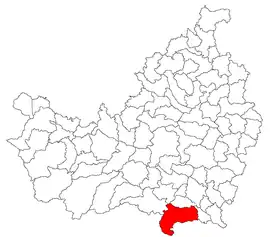Moldovenești
Moldovenești (formerly Orfalău and Varfalău; Hungarian: Várfalva; German: Burgdorf) is a commune in Cluj County, Transylvania, Romania, 12 km southwest of Turda, in the valley of the Arieș.
Moldovenești
Orfalău, Varfalău Várfalva | |
|---|---|
.JPG.webp) Reformed church in Stejeriș | |
 Location in Cluj County | |
 Moldovenești Location in Romania | |
| Coordinates: 46°29′55″N 23°40′13″E | |
| Country | Romania |
| County | Cluj |
| Subdivisions | Bădeni, Moldovenești, Pietroasa, Plăiești, Podeni, Stejeriș |
| Government | |
| • Mayor (2020–2024) | Ioan Mărginean[1] (UDMR) |
| Area | 139 km2 (54 sq mi) |
| Population (2011-10-31)[2] | 3,317 |
| • Density | 24/km2 (62/sq mi) |
| Time zone | EET/EEST (UTC+2/+3) |
| Vehicle reg. | CJ |
| Website | Official website (in Romanian and Hungarian) |
History
The oldest record about the ancient castle at the village is from 1075, calling the place Castrum Turda (the old Turda Castle). During the Tatar invasions of Hungary in the 13th Century, most of the area around the castle was ravaged. Later, the land was given to free Székelys who moved here from the Saschiz region and the territory became part of Aranyos Seat.
Bădeni village has been the site of a crematorium since 2014.[3]
Etymology
The commune was renamed Moldoveneşti in the interwar period, in honour of Ioan Micu Moldovan. The previous name, Varfalău, is derived from Várfalva, which means "village of the castle" in Hungarian.
Component villages
The commune is composed of six villages:
| In Romanian | In Hungarian | Ethnic majority |
|---|---|---|
| Bădeni | Bágyon | Hungarians |
| Moldovenești | Várfalva | Hungarians |
| Pietroasa | Csegez | Romanians |
| Podeni | Székelyhidas | Romanians |
| Plăiești | Kövend | Hungarians |
| Stejeriș | Kercsed | Hungarians |
Vălenii de Arieș (formerly Rachișul de Arieș or for short Rachiș; Aranyosrákos; Krebsbach) was a separate village until 1966, when it was absorbed into Moldovenești village.
Population
At the 2011 census, 56.6% of inhabitants were Hungarians, 39.6% Romanians and 3.8% Roma.
Natives
- Ioan Micu Moldovan - historian and theologian, member of the Romanian Academy
Notes
- "Results of the 2020 local elections". Central Electoral Bureau. Retrieved 11 June 2021.
- "Populaţia stabilă pe judeţe, municipii, oraşe şi localităti componenete la RPL_2011" (XLS). National Institute of Statistics.
- (in Romanian) Florina Pop, "Cum arată 'cuptorul morţii' din Cluj, cel mai modern crematoriu uman din estul Europei", Adevărul, October 9, 2014
References
- Atlasul localităților județului Cluj (Cluj County Localities Atlas), Suncart Publishing House, Cluj-Napoca, ISBN 973-86430-0-7
External links
(in Romanian and Hungarian) Official website of the municipality
